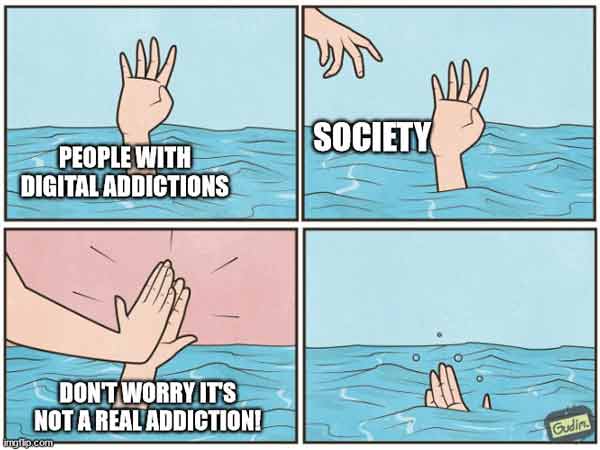Welcome to our digital detoxing series! A series on how to stop addictions to Fortnite,Facebook,Instagram,porn,Netflix, Youtube,Tinder… Find all the posts about digital addiction. Today, let’s talk about how to quit the glow addiction.

- What’s the glow addiction?
- Addiction to glow, a “real” addiction?
- What’s considered glow addiction
- How much glow is too much?
- Some health and fitness addiction facts & statistics
- Symptoms & Causes of the glow addiction
- Why is glow so addictive?
- Possible causes of glow dependency
- Symptoms, Causes and Signs of glow addiction
- Problems, impacts & bad effects of glow
- Some benefits of glow
- health problems
- impact on brain & mental health
- impact on relationships
- How to stop & quit your glow addiction
- Main steps and solutions to break the glow addiction
- Best glow blocker apps & functionalities
- where to seek extra help?
- Conclusion
- To Go Further
- How to help someone with glow addiction
- Best books about health and fitness addiction
- Research about health and fitness addiction
What is the glow addiction?
About glow
Glow is a soft light emitted by an object, typically caused by heat or radiation. It is often associated with a warm, gentle illumination that can create a soothing or comforting atmosphere.
Addiction to glow, a “real” addiction?
Officially an addiction?
First, let’s have a look to the DSM-5,the Diagnostic and Statistical Manual of Mental Disorders. Does it includes glow addiction?
No, “glow addiction” is not listed as a specific disorder in the DSM-5 (Diagnostic and Statistical Manual of Mental Disorders, Fifth Edition), which is the standard classification system for mental health disorders used by clinicians and researchers in the US. However, excessive use of technology or social media can be a symptom of various mental health disorders, such as addiction, anxiety, depression, or attention-deficit/hyperactivity disorder (ADHD).
So what means “glow addiction”?
“Glow addiction” is not a recognized medical or psychological condition. It is a term that has been used colloquially to describe an obsession or excessive focus on achieving a glowing or radiant complexion. It can refer to an unhealthy preoccupation with skincare products and routines, or an excessive use of self-tanning or other beauty treatments to achieve a radiant appearance. However, it is important to note that enjoying skincare or beauty routines is not inherently problematic and varies from person to person.
What is considered glow addiction?
” However, for the purpose of answering your question, here are some potential criteria that could be used to diagnose a “glow addiction”:
- 1. Spending an excessive amount of time on electronic devices that emit a significant amount of blue light,such as smartphones, tablets, or computers.
- 2. Feeling a strong urge or compulsion to use electronic devices that emit blue light,even when it interferes with daily activities or responsibilities.
- 3. Experiencing physical symptoms such as eye strain,headaches, or disrupted sleep patterns as a result of excessive use of electronic devices.
- 4. Neglecting personal relationships or activities in favor of spending time on electronic devices that emit blue light.
- 5. Using electronic devices that emit blue light as a coping mechanism for stress,anxiety, or other emotional issues.
It is important to note that the concept of “glow addiction” is not a recognized disorder or condition by the medical community, and any potential diagnosis should be made by a qualified healthcare provider.
How much glow is too much?
Spending too much time on glow can vary from person to person and their individual needs. It is important to prioritize self-care and balance in all aspects of life, including skincare. It is recommended to follow the usage instructions provided by the product manufacturer and to consult with a dermatologist if you have concerns about excessive use.
Some health and fitness addiction facts & statistics

There is limited research on the prevalence of health and fitness addiction. However, some studies suggest that it may affect up to 10% of the population.
Here are some statistics related to health and fitness addiction:
1. According to a study published in the Journal of Behavioral Addictions, 10% of gym-goers met the criteria for exercise addiction.
2. A study published in the International Journal of Mental Health and Addiction found that individuals with body dysmorphic disorder (BDD) were more likely to have exercise addiction. BDD affects approximately 2% of the population.
3. The National Eating Disorders Association (NEDA) states that excessive exercise is a common behavior among individuals with eating disorders, affecting up to 80% of individuals with anorexia nervosa.
4. A survey conducted by the International Health, Racquet & Sportsclub Association (IHRSA) found that 18% of gym-goers reported feeling guilty if they missed a workout, and 14% felt anxious or irritable if they couldn’t exercise.
It’s important to note that not all individuals who engage in frequent exercise or have a strong interest in health and fitness are addicted. Health and fitness addiction is characterized by compulsive and excessive exercise that interferes with daily life and causes physical and/or psychological harm.
Is the glow addiction widespread?
If you are referring to the beauty and skincare brand “Glow Recipe”, it has gained a significant following and popularity in recent years, but it is not known to be addictive. Addiction can occur with certain substances or behaviors, but it is not typically associated with skincare products.
Symptoms, Causes and Signs of glow addiction
Why is glow so addictive?
Glow, or the feeling of a warm, radiant energy emanating from within, can be addictive for a few reasons.
Firstly, the release of endorphins, a chemical that produces feelings of happiness and pleasure, can be triggered by experiences that create a sense of glow. This can include exercise, being in nature, or achieving a personal goal, among others.
Secondly, the desire for social validation can also play a role in the addiction to glow. When someone experiences a sense of glow, they may receive positive feedback from others, which reinforces the behavior and motivates them to seek out similar experiences in the future.
Lastly, the pursuit of glow can become a habit or routine, as individuals may find that engaging in certain activities consistently leads to a sense of glow. This can create a sense of familiarity and comfort, making it difficult to break the cycle of seeking out glow-inducing experiences.
Possible causes of glow dependency
Glow addiction, also known as screen addiction or digital addiction, is a term used to describe excessive use of electronic devices such as smartphones, tablets, computers, and video game consoles. Some possible causes of glow addiction are:
- 1. Dopamine release:Using electronic devices releases dopamine, a neurotransmitter that is associated with pleasure and reward. This can create a feeling of satisfaction and encourage further use.
- 2. Social pressure:In today’s society, there is a lot of pressure to be connected and up-to-date on social media and other online platforms. This can lead to a fear of missing out (FOMO) and a constant need to check notifications and updates.
- 3. Boredom:Electronic devices can provide a constant source of entertainment and stimulation, which can be hard to replicate in other activities. This can lead to a reliance on electronic devices for entertainment and a difficulty in finding enjoyment in other activities.
- 4. Anxiety and stress:Using electronic devices can be a way to distract oneself from anxiety and stress. However, excessive use can actually increase anxiety and stress levels in the long run.
- 5. Lack of self-control: Some people may have a predisposition to addictive behaviors, which can lead to difficulties in controlling their use of electronic devices.
It is important to note that glow addiction is not an officially recognized medical condition, but excessive use of electronic devices can have negative effects on both physical and mental health.
Signs & Symptoms of glow addiction
Now let’s see if you have the glow addiction problem.
- 1. You have a collection of highlighters:If you have more highlighters in your makeup bag than you know what to do with, you might be a glow addict. You love trying new formulas, shades, and finishes to achieve the ultimate glow.
- 2. You can’t leave the house without highlighter: Even if you’re going for a natural, no-makeup look, you still have to have a touch of highlighter on your cheekbones, nose, and cupid’s bow.
- 3. You’re constantly complimented on your skin: Your friends and family always ask what you’re doing to make your skin look so radiant. You know that it’s all about the glow, and you’re happy to share your tips and tricks.
- 4. You’re always on the hunt for the perfect dewy foundation: You love a foundation that gives you a natural, dewy finish. You’re always trying new formulas and adding them to your collection.
- 5. You’re not afraid to layer your highlighter: You know that the key to a truly blinding glow is to layer your highlighter. You’re not afraid to go all out and apply multiple shades and formulas to achieve the ultimate glow.
- 6. You love experimenting with different colors:You’re not limited to just champagne or gold highlighters. You love trying out different shades like pink, purple, and blue to add a pop of color to your look.
- 7. You’re always excited to try new glow-inducing products: Whether it’s a new illuminating moisturizer, a shimmery body oil, or a luminous setting spray, you’re always excited to try new products that will give you that lit-from-within glow.
Problems, impacts & bad effects of glow: should you quit?

What are some benefits of glow
There are several pros and advantages of glow, which make it a great option for many applications. Here are some of the main reasons why glow is so great:
- 1. Visibility:Glow is highly visible, even in low light conditions, making it ideal for safety applications. It can be used to mark exits, emergency equipment, and other important areas.
- 2. Longevity:Glow can last for up to 10 hours, providing a reliable source of light for extended periods of time.
- 3. Cost-effective: Glow is an affordable alternative to traditional lighting solutions, as it doesn’t require electricity or batteries.
- 4. Low maintenance:Once applied, glow requires little to no maintenance, making it a convenient option for hard-to-reach areas.
- 5. Environmentally friendly:Glow is non-toxic and doesn’t produce any harmful emissions, making it a safe and environmentally friendly choice.
- 6. Versatile:Glow can be used in a variety of applications, including safety signage, decorative elements, and emergency lighting.
Overall, the pros and advantages of glow make it a great option for anyone looking for a reliable, cost-effective, and environmentally friendly lighting solution.But at the opposite, what can be some glow addiction problems addicts suffer from?
general health problems
We can provide some general information about glow and its effects on health.
Glow is a term used to describe the radiant or luminous appearance of the skin. In general, having glowing skin is considered a sign of good health and vitality.
However, there are certain factors that can contribute to a temporary or artificial glow, which may not necessarily indicate good health. For example, excessive use of makeup, skin care products or tanning beds can create a temporary glow, but may have negative effects on the skin and overall health in the long run.
On the other hand, having a healthy diet, staying hydrated, getting enough sleep and exercise, and managing stress can contribute to a natural and long-lasting glow. These habits can also have positive effects on overall health and well-being.
In summary, while having a glow can be a sign of good health, it is important to consider the underlying factors contributing to it and to prioritize healthy habits for long-term benefits.
glow and sleep disorder
Yes, exposure to excessive or disruptive levels of light, including glow, can cause sleep problems or disorders. This is because light exposure can interfere with the body’s natural production of the sleep hormone melatonin, which regulates the body’s sleep-wake cycle. Exposure to glow or bright light before bedtime can suppress the secretion of melatonin, making it harder to fall asleep or stay asleep.
Additionally, exposure to glow during the night can disrupt the quality of sleep and lead to daytime sleepiness and fatigue. Therefore, it is important to limit exposure to glow or bright light before bedtime, especially in the bedroom.
glow affecting your brain & mental health: bad for brain and mental health?
Some effects of glow on your brain
Glow, particularly the blue light emitted by electronic devices such as smartphones, tablets, and computers, can have negative effects on the brain. Here are some of the bad effects of glow on your brain:
- 1. Disrupts sleep:Exposure to glow before bedtime can disrupt the body’s natural sleep-wake cycle, making it harder to fall asleep and stay asleep.
- 2. Causes eye strain:Prolonged exposure to glow can cause eye strain, dry eyes, headaches, and blurred vision.
- 3. Impacts mood:Glow can affect the brain’s production of serotonin, a neurotransmitter that regulates mood, leading to feelings of depression, anxiety, and irritability.
- 4. Affects cognitive function:Exposure to glow can impair cognitive function, including memory, attention, and decision-making.
- 5. Increases risk of neurological disorders:Long-term exposure to glow has been linked to an increased risk of neurological disorders such as Alzheimer’s disease and Parkinson’s disease.
- 6. Impairs melatonin production:Glow suppresses the production of melatonin, a hormone that regulates sleep and other bodily functions, leading to a range of health problems.
Some effects of glow on your mental health
- 1. Insomnia:The blue light emitted by electronic devices can disrupt your sleep cycle and cause insomnia. Lack of sleep can lead to anxiety, depression, and other mental health issues.
- 2. Eye strain:Constant exposure to bright lights can cause eye strain and headaches, which can lead to irritability and difficulty concentrating.
- 3. Agitation:Bright lights can be overstimulating, causing agitation and restlessness. This can be particularly problematic for individuals with anxiety disorders or sensory processing issues.
- 4. Depression:Overexposure to bright lights can disrupt the body’s natural circadian rhythm, which can lead to depression and mood disorders.
- 5. Social isolation:Spending too much time indoors under artificial lights can lead to social isolation and a lack of connection with nature, which can contribute to feelings of depression and anxiety.
It is important to limit your exposure to bright lights and prioritize self-care practices that support mental and physical health.
Does glow cause stress and anxiety?
Glow itself cannot cause stress or anxiety. However, certain situations where glow is present may trigger stress or anxiety in some individuals. For example, if someone is in a dark place and suddenly sees a bright glow, it may startle them and cause anxiety.
Additionally, if someone is in a high-pressure situation where they are being evaluated or judged, the presence of a glow may add to their stress levels. Overall, it is not the glow itself that causes stress or anxiety, but rather the context in which it is experienced.
Can glow addiction lead to sadness and depression?

It is possible for excessive use of technology, including the addiction to glowing screens, to lead to negative effects on mental health, including sadness and depression. Studies have shown that excessive screen time can disrupt sleep patterns, decrease physical activity, and lead to social isolation, which are all factors that can contribute to feelings of sadness and depression. It is important to practice moderation and balance in the use of technology to maintain good mental health.
Dopamine and glow
Dopamine is a neurotransmitter that plays a crucial role in the reward and pleasure centers of the brain. It is released when we experience something pleasurable or rewarding, such as when we eat our favorite food, receive a compliment, or achieve a goal.
The feeling of a “glow” after experiencing something pleasurable or rewarding is often associated with the release of dopamine in the brain. This feeling is characterized by a sense of satisfaction, contentment, and happiness.
Research has shown that activities that release dopamine in the brain, such as exercise, meditation, and spending time in nature, can lead to a sense of “glow” or well-being.
Additionally, drugs that increase dopamine levels, such as certain medications or illicit substances, can also produce a similar feeling of euphoria or “glow.” However, it is important to note that using drugs to achieve this feeling can be dangerous and lead to addiction and other negative consequences.
glow effects on Focus, productivity, attention span, academic performance…
Glow affects focus, productivity, attention span, and academic performance in different ways depending on the individual. Here are some possible effects:
- 1. Focus:The glow from electronic devices can be distracting and make it harder to focus on tasks. This is because the light stimulates the brain and makes it more difficult to tune out distractions.
- 2. Productivity:The glow can also reduce productivity, as it can make it harder to concentrate and complete tasks efficiently. This is especially true if the glow is coming from a social media app or other distracting website.
- 3. Attention span:The glow can shorten attention span, as the constant stimulation can cause mental fatigue and reduce the ability to sustain focus for extended periods of time.
- 4. Academic performance:The glow can have a negative impact on academic performance, particularly if it is interfering with sleep. Lack of sleep can lead to reduced cognitive function, memory problems, and difficulty concentrating in class.
Overall, it is important to be mindful of the impact of glow on focus, productivity, attention span, and academic performance and take steps to minimize its negative effects. This might include limiting screen time, using apps to reduce blue light emissions, and establishing healthy sleep habits.
A word about ADHD and glow
Glow, which is a menstrual cycle tracking app, is not specifically designed to cater to people with ADHD. However, people with ADHD may find such apps useful as they can help with tracking and managing their symptoms. For example, ADHD symptoms often include forgetfulness, lack of focus, and disorganization, which can make tracking menstrual cycles and related symptoms challenging.
Additionally, people with ADHD may interact with Glow differently depending on their specific symptoms and coping mechanisms. For instance, some individuals with ADHD may find it helpful to set reminders or use visual cues to remember to track their menstrual cycles and symptoms. Others may prefer to use the app’s note-taking feature to jot down important information related to their cycles.
In summary, while there is no definitive answer on how people with ADHD interact with Glow, the app may be a useful tool for individuals with ADHD to manage their menstrual cycles and related symptoms.
affecting your relationships
glow and self-esteem
Glow can have a positive effect on self-esteem. When we feel our skin looks healthy and radiant, we tend to feel better about ourselves. This is because our outer appearance can affect how we feel about ourselves on the inside. When we have a healthy glow to our skin, we may feel more confident and self-assured, which can lead to improved self-esteem.
Additionally, taking care of our skin and achieving a glow can give us a sense of accomplishment. When we put effort into something and see positive results, it can boost our self-esteem and make us feel proud of ourselves.
However, it’s important to note that relying solely on external factors, such as having a glow, to boost self-esteem is not a sustainable solution. True self-esteem comes from within and requires a healthy mindset and positive self-talk. It’s important to focus on building a strong sense of self-worth and self-love, rather than relying on external factors to validate our self-esteem.
glow addiction leads to isolation and loneliness?
.jpg)
Yes, addiction to glowing screens can lead to isolation and loneliness. This is because excessive use of screens can cause people to withdraw from their social lives and become more focused on their digital interactions. Individuals may find themselves spending more time alone in front of their screens, rather than engaging in face-to-face interactions with friends and family. This can result in feelings of loneliness and isolation, which can have negative impacts on mental health and well-being. It is important for individuals to find a healthy balance between their screen time and their social interactions to avoid these negative consequences.
Effects of glow on your relationship
Positive effects of glow on your relationship:
- 1. Increased communication:Glow can encourage you and your partner to communicate more often and openly about your needs, wants, and desires.
- 2. More intimacy:Glow can lead to increased physical intimacy between partners, which can strengthen the emotional bond between them.
- 3. Better understanding of each other:Glow can help partners understand each other’s emotions and needs better, leading to a more fulfilling relationship.
- 4. More appreciation for each other:Glow can help partners appreciate each other more, leading to a deeper sense of gratitude and love.
Negative effects of glow on your relationship:
- 1. Unrealistic expectations:Glow can create unrealistic expectations in your relationship, leading to disappointment when those expectations aren’t met.
- 2. Pressure to maintain the glow:Partners may feel pressure to maintain the glow in their relationship, leading to stress and anxiety.
- 3. Lack of authenticity:Glow can cause partners to present a false version of themselves, leading to a lack of authenticity in the relationship.
- 4. Comparison to others:Glow can lead to comparisons with other couples, which can create feelings of inadequacy and jealousy.
How To Stop & quit Your glow Addiction
Finally you think you are addicted to glow and you are wondering how to quit it? How to break and overcome your cravings for glow?
Here are the best solutions, steps, supports, resources and help you can get to treat your glow addiction.
Main steps and solutions to break the glow addiction
Here are some steps to help get rid of glow addiction:
- 1. Identify the root cause:Reflect on why you feel the need to use glow products excessively. Is it because you want to feel confident or attractive? Or is it because you are trying to cover up insecurities?
- 2. Set realistic goals:Set small, achievable goals for yourself. For example, start by reducing your use of glow products by 10% every week.
- 3. Find alternative activities:Find new activities to replace your glow addiction. This can be anything from reading a book to taking a walk outside.
- 4. Seek support:Reach out to friends and family who can support you through this process. You can also seek professional help if you need it.
- 5. Practice self-care: Take care of yourself by eating a healthy diet, getting enough sleep, and exercising regularly. This will help boost your confidence and reduce the need for external validation.
- 6. Celebrate your progress:Celebrate your small successes along the way to help keep you motivated and focused on your goals.
Actually, that’s what most documentation out there is about… However, quitting a digital addiction can be a bit trickier than that.
So our team, after testing many ways, designed a bulletproof way to overcome them. Here are some clear and practical steps that are very powerful to quit a digital addiction, including glow:
1. Purge temptations: Get rid of glow
First, cleaning your life from temptations is much easier than resisting to them. Disable or delete your glow accounts, change the password and hide it somewhere you can’t access easily, keep your phone / computer far away… Out of sight out of mind.
Here is a video from our course the The Digital Purge. on how to add resistance to your temptations, so you become so lazy to engage with them that you give them up:







